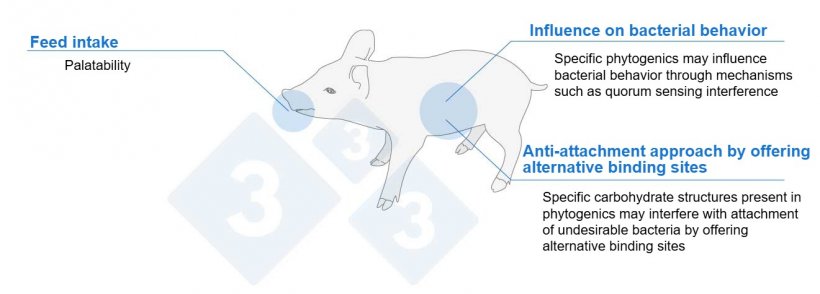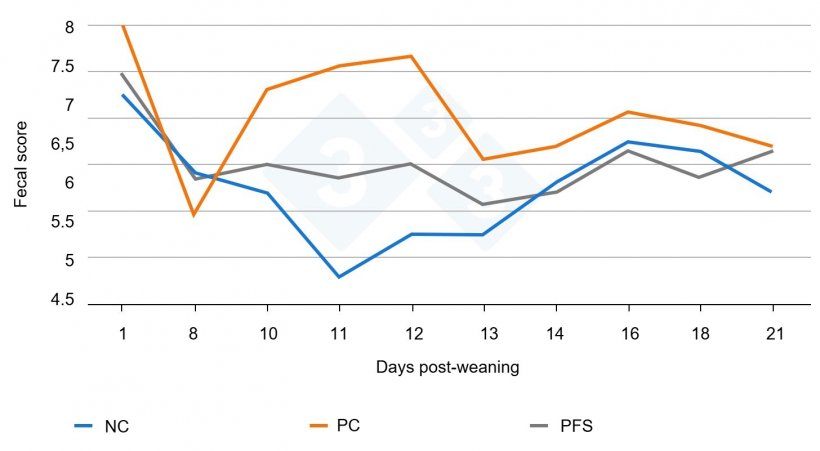The weaning period is one of the most critical and challenging stages in a piglet’s life. When piglets are weaned, they often experience a drop in feed intake and a shift in gut microbiota. This can result in an imbalanced gut environment, also known as bacterial dysbiosis, which increases susceptibility to undesirable bacteria like enterotoxigenic Escherichia coli (ETEC). This strain of E. coli, particularly the F4 and F18 types, is the leading cause of post-weaning diarrhoea (PWD). PWD affects nearly one in four piglets in Europe.
Traditionally, antibiotics and high doses of zinc oxide (ZnO) have been widely used to control gut imbalances and fight infections during this time. However, with the European Union’s ban on in-feed antibiotics (2006) and the more recent prohibition of therapeutic ZnO use (2022), pig producers are being pushed towards a variety of management and nutritional practices. This is where phytogenics can potentially come into play.

Definition and modes of action
Phytogenics are bioactive compounds derived from plants, such as essential oils, herbs, spices, and other botanical extracts. These substances have long been recognised for their beneficial effects in both human and animal health and are now gaining momentum as a reliable tool to support piglets through weaning (Madesh et al, 2025). However, their modes of action depend on the active substances involved. Other parameters like the genus of the plant, its location, the climate, the harvesting method and the production process are influencing the type and concentration of active substances and are critical for sourcing (Biswas and Kim, 2025).
To have the maximum efficiency of the phytogenic based solution it is important to understand that within the same plant, there are synergistic effects between various substances. Moreover, there are synergistic effects within the same substance group and between substance groups. These effects combined triggers multiple modes of action.
Benefits of phytogenics for piglets
Selected phytogenics can support feed intake, growth performance and gastrointestinal health in post-weaned piglets (Figure 1).

Phytogenics comprise a diverse range of bioactive compounds with multiple modes of action:
- Phytogenics can disrupt the communication of undesirable bacteria, helping to reduce biofilm formation.
- Certain compounds can serve as alternative binding sites, blocking bacteria from adhering to the gut lining.
- Specific phytogenic substances may help reducing intestinal permeability. supporting efficient nutrient absorption and strengthening overall resilience in animals.
- Specific phytogenics can enhance the body's ability to neutralize reactive oxygen species, as evidenced by increased activity of key antioxidant enzymes like superoxide dismutase (SOD) and glutathione peroxidase (GPX), along with decreased levels of malondialdehyde (MDA), a marker of lipid peroxidation.
Scientific validation of phytogenics
To help mitigate post-weaning challenges like post-weaning diarrhoea (PWD) in piglets, specific phytogenic compounds, such as essential oils (e.g., carvacrol), spices (e.g., turmeric), and mucilaginous plants (e.g., fenugreek), have shown notable potential in previous research (Internal data).
For instance, one study found that carvacrol reduced the adhesion of Streptococcus suis to intestinal mucus derived from piglets. Other studies have indicated that fenugreek can modulate the attachment of undesirable bacteria (Axmann et al,2021; Badia et al, 2012)
There is also an ongoing work to bridge scientific insights with practical, on-farm applications. One of the recent farm trials in Spain demonstrated the significant benefits of using a phytogenic blend during the weaning period. Piglets receiving the phytogenic feed solution showed:
- 7.8% increase in Average Daily Feed Intake (ADFI)
- 15% increase in Average Daily Gain (ADG)
- 3.6% improvement in Feed Conversion Ratio (FCR)
- Reduced mortality and removals from 7.6% to 4.9%
The trials were 4 performed in several countries (Germany, NL, Spain, Czech Republic), duration varies between 21-42 days, starting BW between 6-8 kg, with dose always 1 kg/t of a blend of herbs, plant extract and essential oils from Lamiaceae, Schisandraceae, Zingiberaceae and Fabaceae families.
In January 2025, a peer-reviewed study (Torres-Pitarcho et al., 2025) supported these findings. In this experimental trial, piglets challenged with F4-ETEC on day 10 post weaning and supplemented with a phytogenic feed solution (PFS) based on at a doses of 1 kg/t of this blend had significantly lower levels of bacterial shedding on days 13, 14, and 16 post-weaning, compared to the control group (Figure 2). The phytogenic group also showed reduced duration of diarrhea, better stool consistency was supported, and jejunal histomorphology was improved as a result of PFS supplementation (Figure 3).
The goal was to evaluate this phytogenic blend in E.coli challenged piglets. Our hypothesis was to keep performance and especially feed intake stable or even increase and to reduce negative impacts of E.coli challenge, like diarrhea incidence, E.coli shedding and alterations in gut morphology. By looking on those parameters, all above listed MoA play an important role.

Colistin (Colisol 250 000 IE/ml) was used as positive control and applied via drinking water between d8 and d14 post-weaning. Colistin was used as the gold standard against E. coli. Even now there are many restrictions using colistin.


Conclusion
Phytogenics encompass a wide variety of bioactive compounds that can potentially act through multiple mechanisms, and growing research highlights their broad benefits for livestock resilience and productivity. These advantages can include promoting early feed intake, supporting digestive efficiency and immune function, modulating the gut microbiota, and supporting antioxidant status.
Growing evidence and a deeper understanding of phytogenics are enhancing our ability to tackle post-weaning challenges, particularly during the critical first 14 days after weaning. This knowledge is driving the development of innovative, commercially viable phytogenic solutions. Many of these new feed solutions are formulated using advanced technologies, such as microencapsulation, to protect the stability and bioavailability of active compounds until they reach the piglet’s gut.
In summary, while phytogenics are often applied at low inclusion rates, their targeted mechanisms of action can deliver a significant impact through animal nutrition. By harnessing these effects, phytogenics can play a vital role in reducing the impact of post-weaning diarrhea (PWD) and support piglet resilience and performance worldwide.


